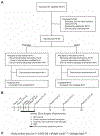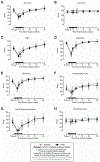The Use of Recombinant Human Growth Hormone to Protect Against Muscle Weakness in Patients Undergoing Anterior Cruciate Ligament Reconstruction: A Pilot, Randomized Placebo-Controlled Trial
- PMID: 32452208
- PMCID: PMC7351248
- DOI: 10.1177/0363546520920591
The Use of Recombinant Human Growth Hormone to Protect Against Muscle Weakness in Patients Undergoing Anterior Cruciate Ligament Reconstruction: A Pilot, Randomized Placebo-Controlled Trial
Abstract
Background: Anterior cruciate ligament (ACL) tears are common knee injuries. Despite undergoing extensive rehabilitation after ACL reconstruction (ACLR), many patients have persistent quadriceps muscle weakness that limits their successful return to play and are also at an increased risk of developing knee osteoarthritis (OA). Human growth hormone (HGH) has been shown to prevent muscle atrophy and weakness in various models of disuse and disease but has not been evaluated in patients undergoing ACLR.
Hypothesis: Compared with placebo treatment, a 6-week perioperative treatment course of HGH would protect against muscle atrophy and weakness in patients undergoing ACLR.
Study design: Randomized controlled trial; Level of evidence, 2.
Methods: A total of 19 male patients (aged 18-35 years) scheduled to undergo ACLR were randomly assigned to the placebo (n = 9) or HGH (n = 10) group. Patients began placebo or HGH treatment twice daily 1 week before surgery and continued through 5 weeks after surgery. Knee muscle strength and volume, patient-reported outcome scores, and circulating biomarkers were measured at several time points through 6 months after surgery. Mixed-effects models were used to evaluate differences between treatment groups and time points, and as this was a pilot study, significance was set at P < .10. The Cohen d was calculated to determine the effect size.
Results: HGH was well-tolerated, and no differences in adverse events between the groups were observed. The HGH group had a 2.1-fold increase in circulating insulin-like growth factor 1 over the course of the treatment period (P < .05; d = 2.93). The primary outcome measure was knee extension strength, and HGH treatment increased normalized peak isokinetic knee extension torque by 29% compared with the placebo group (P = .05; d = 0.80). Matrix metalloproteinase-3 (MMP3), which was used as an indirect biomarker of cartilage degradation, was 36% lower in the HGH group (P = .05; d = -1.34). HGH did not appear to be associated with changes in muscle volume or patient-reported outcome scores.
Conclusion: HGH improved quadriceps strength and reduced MMP3 levels in patients undergoing ACLR. On the basis of this pilot study, further trials to more comprehensively evaluate the ability of HGH to improve muscle function and potentially protect against OA in patients undergoing ACLR are warranted.
Registration: NCT02420353 ( ClinicalTrials.gov identifier).
Keywords: anterior cruciate ligament; human growth hormone; muscle atrophy; orthobiologics; somatropin.
Figures





References
-
- Anderson AF, Irrgang JJ, Kocher MS, Mann BJ, Harrast JJ; Committee I. The International Knee Documentation Committee Subjective Knee Evaluation Form: normative data. Am J Sports Med. 2006; 34(1):128–135. - PubMed
-
- Bidlingmaier M, Friedrich N, Emeny RT, et al. Reference intervals for insulin-like growth factor-1 (IGF-I) from birth to senescence: results from a multicenter study using a new automated chemiluminescence IGF-I immunoassay conforming to recent international recommendations. J Clin Endocrinol Metab. 2014;99(5):1712–1721. - PubMed
Publication types
MeSH terms
Substances
Associated data
Grants and funding
LinkOut - more resources
Full Text Sources
Medical
Miscellaneous

